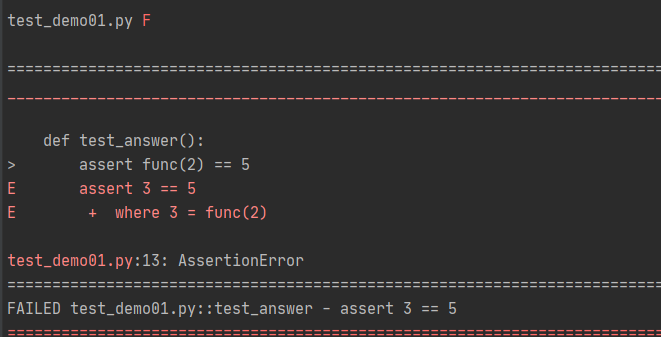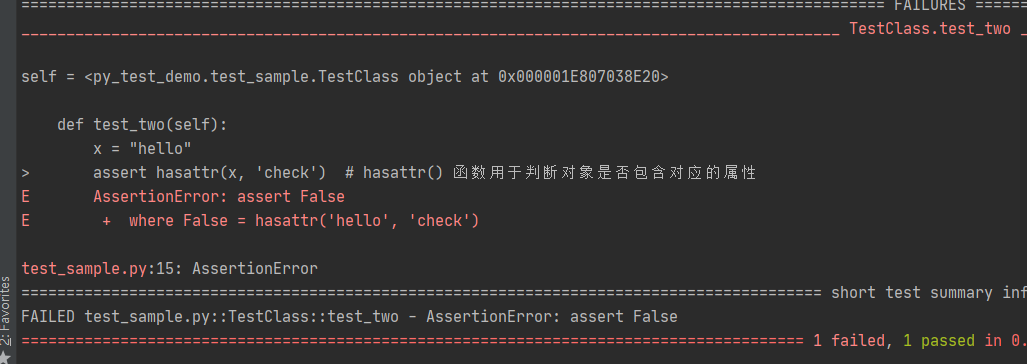一、Pytest基础
Pytest特点:
1.非常容易上手,入门简单,文档丰富,文档中有很多实例可以参考
2.能够支持简单的单元测试和复杂的功能测试
3.支持参数化
4.执行测试过程中可以将某些测试跳过(skip),或者对某些预期失败的case标记成失败
5.支持重复执行(rerun)失败的case
6.支持运行由nose, unittest编写的测试case
7.可生成html报告
8.方便的和持续集成工具jenkins集成
9.可支持执行部分用例
10.具有很多第三方插件,并且可以自定义扩展。
Pytest安装
pip install -U pytest
查看版本:pip show pytest/pytest --version
举个栗子
例1、
def func(x): return x + 1 def test_answer(): assert func(2) == 5

例2、
class TestClass: def test_one(self): x = "three" assert 'h' in x def test_two(self): x = "hello" assert hasattr(x, 'check') # hasattr() 函数用于判断对象是否包含对应的属性

【备注:-s参数是为了显示用例的打印信息。 -q参数只显示结果,不显示过程】
Pytest用例规则:
1.测试文件以test_开头(以_test结尾也可以)
2.测试类以Test开头,并且不能带有__init__方法
3.测试函数以test_开头
4.断言使用assert
5.所有的包package必须要有__init__.py文件
执行用例规则:
1.执行某个目录下所有的用例
pytest 文件名/
2.执行某一个py文件下用例
pytest 脚本名称.py
3.-k 按关键字匹配
pytest -k
"MyClass and not method"
4.按节点运行
pytest
test_mod.py::test_func
5.运行.py模块里面,测试类里面的某个方法
pytest
test_mod.py::TestClass::test_method
6.标记表达式
pytest -m slow # 将运行用@pytest.mark.slow装饰器的所有测试
7.从包里面运行
pytest --pyargs
pkg.testing # 这将导入pkg.testing并使用其文件系统位置来查找和运行测试
8.-x 遇到错误停止测试
pytest -x
test_class.py
二、测试用例的setup和teardown
用例运行级别
模块级(setup_module/teardown_module)开始于模块始末,全局的
函数级(setup_function/teardown_function)只对函数用例生效(不在类中)
类级(setup_class/teardown_class)只在类中前后运行一次(在类中)例子
方法级(setup_method/teardown_method)开始于方法始末(在类中)
类里面的(setup/teardown)运行在调用方法的前后。
举个栗子
例1:
import pytest class TestCase(): def setup(self): print("setup: 每个用例开始前执行") def teardown(self): print("teardown: 每个用例结束后执行") def setup_class(self): print("setup_class:所有用例执行之前") def teardown_class(self): print("teardown_class:所有用例执行之前") def setup_method(self): print("setup_method: 每个用例开始前执行") def teardown_method(self): print("teardown_method: 每个用例结束后执行") def test_one(self): print("正在执行----test_one") x = "hello" assert 'h' in x def test_two(self): print("正在执行----test_two") x = "hello" assert hasattr(x, 'check') def test_three(self): print("正在执行----test_three") a = "hello" b = "hello world" assert a in b if __name__ == "__main__": pytest.main(["-s", "test_class.py"])